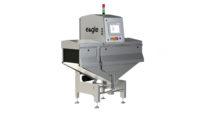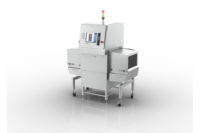Producing a quality product every time delivers a competitive edge to meat processors and packers. Product recalls can cost manufacturers precious profits and tarnished brand reputations while undermining public confidence in the industry. Physical contaminants, such as dense plastics and metals, continue to present significant challenges to the meat industry as a whole, requiring improved inspection performance while delivering ever increasing production rates. Directly responding to the food quality and safety needs of meat and bulk food products, Eagle Product Inspection (Eagle) launched three new x-ray inspection and fat measurement technologies at Process Expo (Booth #1216 – East Hall) Chicago, Illinois, September 15-18, including the EagleFA3/M inline fat measurement and contaminant detection, the Eagle Pipeline, and the Eagle Bulk 540 PRO. All systems ensure product quality, providing thorough inspection, identification and removal of hazardous physical contaminants including calcified bone fragments, small glass shards, mineral stone, rubber, dense plastics, and metal filings.
“What we are finding is manufacturers need to inspect for contaminants earlier in the production process. Earlier detection allows manufacturers to minimize wasted products and protect machinery further down the line from damage. Our new technologies are designed for pumped products and also, for bulk meat, wet and dry foods, and give more accurate detection before adding value to the product. A meat producer can also ensure it is getting the correct amount of fat to lean ratio from its supplier by having our FA3/M system to inspect supplies.” said Kyle Thomas, Strategic Business Unit Manager, Eagle Product Inspection. “We are continuously advancing our portfolio of technologies to deliver the results that our customers are looking for, which are better and finer contaminant detection and a higher quality of product.”
The newest addition to Eagle’s FA3 fat analysis platform, the Eagle FA3/M, meets the needs of manufacturers requiring multiple applications, ranging from fresh, hot-boned, chilled and frozen in loose bulk or carton and crate formats. Quality is ensured for meat processed on the production line by the use of Eagle’s third generation Dual Energy X-ray Absorptiometry (DEXA) technology that discriminates between fat and lean portions of 100 percent of the throughput products. Throughput is further enhanced by Eagle’s proprietary inspection software, which enables the FA3/M to inspect up to 2,400 plastic crates or frozen blocks per hour or up to 35 tons of bulk meat per hour.
Recalibration of the FA3/M is simply achieved with the touch of a button with AUTOCAL and is now complete in approximately one minute, saving hours of lost production time when compared to the manual calibration procedures of standard fat analysis technologies. This automatic calibration eliminates the need for handling bulky, unsanitary and potentially unsafe phantom blocks on the factory floor. Another unique feature to the Eagle inline fat measurement systems is VALIDATE. This function validates calibration and records the result in a secure electronic log. The FA3/M also allows processors to job change easily and seamlessly using PRODUCT SWITCH, which means products with different inspection requirements can run on the same line by simply scanning a bar code. As size can present a challenge on crowded production floors, the FA3/M has compact x-ray imaging geometry that offers improved precision, enhanced contaminant detection and weight measurement, while also maintaining the smallest factory footprint in the industry.
Also new on the show floor was the Eagle Pipeline, an x-ray inspection system designed to create a wall of defense against physical contamination in pumped products. These include liquids, solids, slurries and even whole muscle meat, inspected prior to further processing and packaging when contaminants are easier to find and less expensive to remove. Featuring an innovative approach that reconfigures the product flow to evenly distribute product during inspection, the Eagle™ Pipeline enables thorough inspection and eliminates the challenge of inspecting different densities that can occur when dealing with a round pipe. To reduce product waste, while maintaining product flow, the system has the option of a ball valve reject or a unique blade reject valve designed for muscle product that removes only the contaminated area. The pipeline is available in 2.5, 3, 4 or 6 inch diameters to cater to the needs of different manufacturers allowing easier flow, thereby reducing product jams that result in downtime.
For manufacturers of bulk foods other than meat products, Eagle launched the Eagle Bulk 540 PRO x-ray inspection system to provide accurate inspection of high-volume dry and wet loose foods such as nuts, grains, sugar, cereals, fresh and frozen fruits and vegetables. Product depth is more uniform across the belt due to the innovative cupped conveyor with raised edges that simultaneously reduces product spillage and limits wasted product, a common challenge with conventional flat belt designs. Efficiency and profitability are enhanced with the Eagle Bulk 540 PRO’s eight-lane flap rejection mechanism, each covering one eighth of the belt. Manufacturers can feel safe knowing substandard products will not reach the end of the line because contamination is removed during the production process and rejection of good product is minimized. The Bulk 540 PRO is designed to meet rigorous hygienic standards of the food industry where frequent machine inspections and cleaning are a requirement. Hinged louvers and easy belt removal allow a single operator to disassemble the entire machine in a matter of minutes for thorough sanitation and quickly reassemble to maximize production uptime.
Visit www.eaglepi.com for more information.




Report Abusive Comment